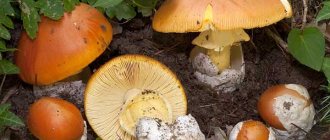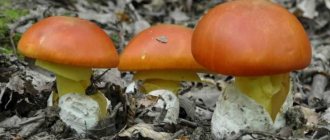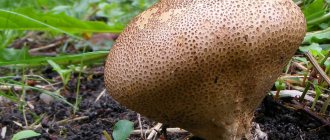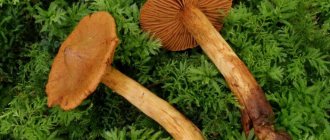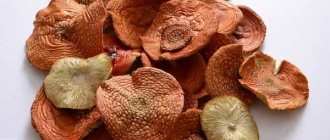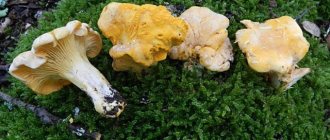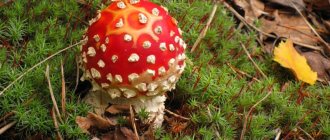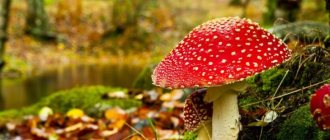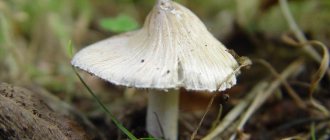They scare small children with fly agaric, telling them how dangerous and poisonous this mushroom can be. Indeed, the fly agaric, especially the royal one, is fraught with danger. But at the same time, he is incredibly beautiful and interesting. Belongs to the fly agaric family, the species amanita regalis. This mushroom is not only poisonous, but also hallucinogenic. And it is found in central Russia closer to the north. What do you need to know about these mushrooms? Is it possible to use it for medicinal purposes, or is it better to avoid this forest dweller? Let's talk about this
Description of the mushroom and its features
Fly agaric belongs to the lamellar mushrooms of the Amish family. The bright, elegant appearance of this forest dweller is very deceptive - it is a poisonous fungal root, which is a symbiosis of mycelium (mycelium) with the roots of various plants and trees. At the moment, there are more than 600 species of fly agarics in nature, and their color is not always bright red; the caps can be brown, yellow and white. The most famous varieties are royal, Caesar, panther, and red fly agaric.
Externally, the ordinary red fly agaric is a large, fleshy mushroom; its cap can be thinner or thicker, sometimes with a small tubercle. White flakes are located along it - these are preserved tissue segments in the process of formation. The base of the leg expands towards the ground. The ring or “skirt” in the upper part of the leg is a shell in which young individuals are enclosed; reproduction occurs with the help of spores.
Not everyone knows that the most poisonous mushroom, the toadstool, poisoning with which can lead to death, also belongs to the fly agaric family. The diameter of its cap can be 10-14 cm, the leg is high - up to 12 cm. Just a few grams of this mushroom are enough for poisoning to lead to death. A special feature of the toadstool is the presence of a filmy ring, thanks to which it can be distinguished from such similar floats, russula and champignons.
Composition and properties
The body of the mushroom contains several types of toxic components, which are mainly found in the cap and its skin; the stem has a lower content.
The chemical composition of the most common red fly agaric is represented by the following substances:
- muscimol is a hallucinogen that has a hypnotic, sedative effect and can disrupt the functioning of consciousness;
- ibotenic acid is a toxic substance that has a destructive effect on brain cells;
- muscarine is a natural alkaloid that leads to vasodilation and the inability of the heart to fully contract; as a result of its entry into the body, poisoning occurs with all the characteristic symptoms - decreased blood pressure, nausea and vomiting;
- muscaruphine is an antibacterial substance, which, moreover, has anti-inflammatory and antitumor properties, which makes it possible to use the mushroom for medical purposes;
- Muscazone is formed as a result of the breakdown of ibotenic acid and is characterized by a weak effect on the functioning of the nervous system.
Most toxic substances accumulate in fly agaric in spring and summer, and at this time it is especially dangerous.
Fly agarics feed on organic matter, since they are not able to absorb carbon dioxide from the air, and they also do not contain chlorophyll.
Microscopic amounts of these poisons are successfully used in pharmacology to create drugs for insomnia, joint diseases, colds, infectious diseases and cancer. Preparations created using fly agaric successfully heal wounds, relieve pain and spasms, increase immunity, and prevent bleeding.
Virulence
Royal fly agaric consists of a large number of toxic substances, the use of which can be fatal. The first symptoms of poisoning include: pain in the abdomen, vomiting, dizziness, migraine. These signs of poisoning appear literally 30-90 minutes after eating royal fly agarics. A little later, damage to the nervous system may occur, which causes hallucinations and convulsions. The extreme symptom is loss of consciousness.
If the above signs of departure appear, you must immediately call an ambulance. Before the doctors arrive, it is recommended to rinse the stomach and warm the patient with a blanket and a heating pad.
Varieties
Fly agarics live, in fact, everywhere - species of this mushroom can be seen in deciduous and coniferous forests of Russia and many other countries. They are also found in colder areas, such as the tundra.
In addition to the red fly agaric, which grows everywhere, there are other varieties that differ in appearance:
- Toadstool or yellow toadstool. The mushroom has an unpleasant odor, a hemispherical white cap with snow-white spots. Most often, you can find it in coniferous or deciduous forests, from July to October.
- Panther fly agaric. It has a brown color, a cap from 5 to 12 cm and a cylindrical leg of approximately the same height with a porous surface and a low, fragile frill. It has an unpleasant smell and the flesh is white.
- Royal fly agaric. You can see it in an oak or beech grove, in a pine forest. This variety, when poisoned, can cause severe hallucinations. It is a large (brown or olive-colored) mushroom with a cap diameter of up to 20 cm and yellow flakes. The color of the pulp is yellow-brown and does not darken when cut. This mushroom loves forests with a predominance of birch, spruce and pine; it is widespread in our country, in Europe, and is found in Korea, England, and Alaska.
- Rough fly agaric. It is a small, fleshy, yellowish or olive-colored mushroom with a thick stalk. In young mushrooms, the cap is almost round and resembles a ball; in adults, it is flat, and the edges may slightly bend upward. When cut, the white flesh quickly turns yellow and its smell, unlike other types, is pleasant. Fly agaric grows both in Europe and America, Japan, South and Central Asia. In nature, however, it can be difficult to see; it prefers to grow next to hornbeams, beeches, and oak groves.
- Spiny-headed fly agaric (bristly, fat). This mushroom is distinguished by an umbrella fleshy head; in young individuals it is round. The cap is covered with gray warts. A distinctive feature is a thick white leg in the middle with scales at the base. The plates of an adult fly agaric are pink in color, the flesh is dense and has a pungent odor. Prefers symbiosis with coniferous trees and oaks, often growing near water bodies. This is a poisonous variety that can cause poisoning even after heat treatment.
Toadstool fly agaric
Panther fly agaric
Royal fly agaric
Fly agaric rough
Spiny-headed fly agaric
Almost all types of mushrooms are unusually beautiful - this is a kind of warning that they are deadly poisonous.
Distribution area
The fruiting period for royal fly agarics begins in July and ends in November. They prefer to grow in spruce and mixed forests. They grow in soils in small groups, but most often alone. Widely distributed throughout northern and central Europe. Found in the northern regions of Russia.
Is it possible to eat fly agarics?
Some types of fly agarics are considered conditionally edible. These include the following mushrooms:
- A yellowish-brown fly agaric, which is also popularly called a fly agaric.
It is not particularly popular due to the fact that it has a thin cap and is not particularly fleshy, at the same time, it is so similar to a toadstool that many do not want to take risks. In its raw form, the float is poisonous and, indeed, dangerous, but after careful heat treatment it is quite suitable for food. The mushroom has a cap up to 8 cm in diameter, brown or brown-orange in color, it is flat, and in the center there is a small darker tubercle. The leg is fragile and high up to 15 cm with a thickening at the base. A distinctive feature is the absence of a ring on it. To the touch, the fly agaric is watery, with a coating of mucus, and there is no smell. - The cone-shaped fly agaric is a thick-fleshy mushroom with a hemispherical cap, white or gray, covered with pointed pyramidal warts. The leg is cylindrical, wide at the base. This mushroom grows in coniferous and deciduous forests, often forming mycorrhiza with linden, beech, and oak. It contains small amounts of muscimol and ibotenic acid, so before use it is boiled and the broth is drained.
- Caesar mushroom is also edible and has excellent taste. Its differences from its poisonous counterparts: the cap is red-orange, smooth and without growths;
- plates and legs are golden yellow;
- the mushroom has a wide sac-like covering at the bottom of the stem.
Mushroom "Float"
Pineal fly agaric
Caesar's fly agaric
Also, edible varieties are brown, gray, snow-white floats, pink and tall fly agaric. Of course, they all require proper preparation and pre-boiling.
Application of mushrooms
As it turns out, the correct use of poisonous mushrooms can save a person from many ailments. They are used both externally and internally.
With a strictly calculated dosage, fly agaric is recommended for problems such as:
- skin diseases - diathesis, eczema, neurodermatitis;
- muscle and joint pain;
- headache;
- radiculitis and rheumatism;
- male impotence;
- eye diseases;
- diabetes;
- tuberculosis;
- epileptic seizures;
- oncological lesions.
And this is not a complete list of all the diseases for which this mushroom can help.
The common red fly agaric, which is the most common, can be used in the form of an alcohol tincture, juice, dried raw material, or ointment. All these remedies are used externally for varicose veins, for healing long-lasting wounds, for burns, bruises, and joint inflammation.
The tincture can be prepared with alcohol or vodka. The crushed caps should be kept in the refrigerator for three days, after which they are filled into a jar and poured 1 cm above the mushrooms. Leave the mixture for 15 days in a dark place and filter.
The ointment can be prepared from fresh mushrooms, grinding them into a paste and mixing with sour cream. Or first prepare the powder by drying the fly agaric caps, then grind them and add Vaseline or vegetable oil to them.
Today, special medicines based on poisonous mushrooms have already been released - fly agaric ointment, tincture, medicinal creams, homeopathic preparations.
Hallucinogenic effect
This effect is strictly individual, and largely depends on the strength and susceptibility of the human body itself, the place where this poisonous mushroom grows, and the dosage.
The first signs of poisoning begin to appear an hour and a half after eating, when convulsions and trembling begin, and the person steadily falls asleep. If a person begins to doze, he has visions, while he remains sensitive to extraneous external sounds.
If a person is not dozing, but is awake, he experiences hallucinations - visual and auditory. Sometimes a person behaves inappropriately. The duration of this effect is from 6 hours to 1 day (again, this depends on many factors). But there is also “pleasant” news - upon completion of the effect of poisoning with this species, there is no hangover syndrome.
Nausea and stomach pain also occur after an hour and a half, and if you eat mushrooms on an empty stomach, then much faster.
In 1979, a case was recorded in Finland when three mushroom pickers mistook these poisonous mushrooms for umbrella mushrooms. Two hours after consuming them, severe indigestion occurred, and after some time they began to experience nervous agitation and hallucinations.
Also, this type of mushroom has the ability to accumulate large quantities of heavy metals, mainly vanadium.
A toxic dose for humans is considered to be 0.25 mg of vanadium, lethal - 2-4 mg. Now compare: studies have shown that per kilogram of dry fruit bodies of the royal fly agaric there are 38-169 (!) mg of this metal. And for 1 kg of fresh - approximately 119 mg.
It’s clear that no one eats a whole kilogram of fly agarics, but why risk your health like that? Moreover, when vanadium accumulates in the body, the likelihood of developing tumors increases.
Useful tips for choosing
When using mushrooms yourself, you need to be able to choose them correctly:
- the most useful, as well as harmful, substances are contained in the cap - this part must be intact, untouched by insects;
- when drying the caps, the plates are removed from them and then strung on a thread;
- when using, it is important to follow the recipe and the exact proportions of all ingredients;
- People with a diseased digestive system should avoid use;
- When making ointments and other products, metal utensils and metal utensils should be avoided.
This product is contraindicated in any form for people with mental disorders and pregnant (nursing) mothers.
At the end of use, it is advisable to thoroughly wash your hands with detergents; ideally, it is better to prepare a tincture or ointment while wearing rubber gloves. Internal preparations from fly agarics can only be taken after consultation with a treating specialist and under his supervision. For children, except in rare cases, mushroom-based medicines are not used.
It should be remembered that just four eaten fly agaric caps are enough to become poisoned without a chance of survival. Such poisonings may be accompanied by suffocation, delirium, convulsions and respiratory paralysis.
A poisonous mushroom, such as the fly agaric, is a living example of the inconsistency that is so characteristic of any living creature on our planet. On the one hand, it is extremely dangerous, on the other hand, it is beautiful, just like its appearance, and brings obvious benefits in the treatment of humans. All that remains is to use this undeniable gift of nature with respect and caution.
0
0
Copy link
Help with poisoning
So, let's consider a situation in which you or another person still confused some type of mushroom and ate the royal fly agaric. How to proceed in this case.
So, if fly agaric was consumed, and you found out about it in advance, even before nausea, hallucinations and stomach upset appeared, you need to induce vomiting. The easiest way is to “two fingers in your mouth” and lean over the toilet. If there is an opportunity to help yourself in other ways, be sure to do so.
If the vomiting has stopped, be sure to eat a sorbent, for example, such as Polysorb. It would also be great to use prebiotics, such as Linex.
Also, you should consult a doctor.
If the first signs of poisoning and hallucinations appear, or you simply were unable to induce vomiting, then you need to urgently contact an ambulance. Doctors are trying to help on the spot or take the victim to the hospital. Without thorough medical care, it is very difficult to get out of such a state and not suffer consequences.
As a rule, the patient’s stomach is washed, and droppers are given with saline and special medications that should increase immunity, and therefore the body’s resistance to toxic substances in the composition of the royal fly agaric.
The patient must remain under medical supervision for a period of 2 days to one week, depending on the severity of his condition.
While a person is going into himself, he needs to choose food very carefully, since the body has suffered consequences after consuming a poisonous mushroom. You are allowed to drink broths, eat steamed fish and some types of cereals.
Trying home treatment can be dangerous.
If a child is poisoned by mushrooms, do not try to induce vomiting, but immediately pack up and go to the nearest hospital.
This mushroom is on Wikipedia.
